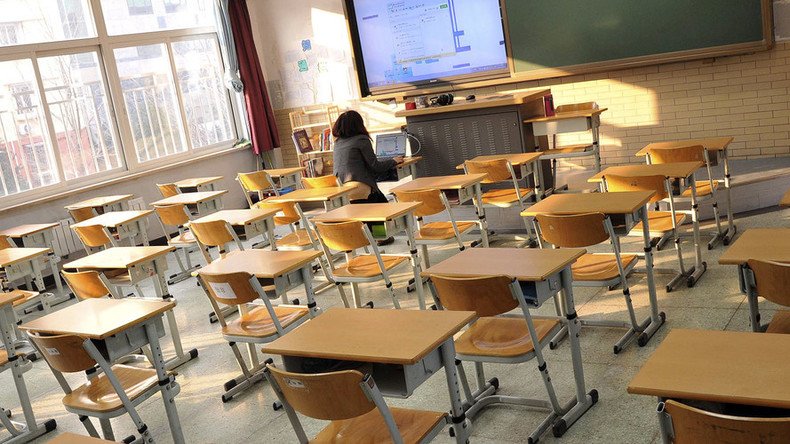Race for good schools is increasing US income segregation – study

The gap between the haves and have-nots in the US is widening, and a new study shows that income segregation is increasing most quickly among families with children, as parents jockey for real estate with access to the best schools.
Since 1990, decisions by wealthy parents regarding where to live have become increasingly driven by the quality of the schools their children could attend, a study published in the American Sociological Review showed. They may not be buying lakefront properties or homes in bustling urban areas, but they are spending top dollar on homes in quality school districts.
This has resulted in more children living in neighborhoods that are more affluent, more segregated by income, and less diverse. Households without children haven’t seen the same rise in income segregation, perhaps because they don’t pay premium dollars for housing based on schools and instead spend their cash on other pursuits such as travel, entertainment or luxury goods.
90+ Detroit schools close as teachers protest city’s refusal to pay them [VIDEO] https://t.co/L8iLWTW9W8@anyaparampil@DetroitEducator
— RT America (@RT_America) May 3, 2016
“Forty to fifty years of social-science research tells us what an important context neighborhoods are, so buying a neighborhood is probably one of the most important things you can do for your kid,” Ann Owens, a sociologist at the University of Southern California and leader of the latest study, told the Washington Post. “There’s mixed evidence on whether buying all this other stuff matters, too. But buying a neighborhood basically provides huge advantages.”
Between 1990 and 2010, income segregation in America’s 100 largest metropolitan areas spiked 20 percent among families with children, the Post reported. In families with kids under 18 years of age, income segregation was two times higher than those without.
Outside of trying to find homes in particular school districts, it’s possible that intense jockeying for homes is occurring within each district itself, as parents try to get their kids into a specific school.
Rising income segregation has raised multiple concerns, particularly about how to ensure diversity at educational facilities and how to ensure less wealthy families still have access to quality schools for their children. In perhaps the worst case in the US, families in Detroit, Michigan have had to contend with the fact that oftentimes simply getting to school can be a huge problem.
High lead levels contaminating water fountains in Boston schoolshttps://t.co/CMpJRcsajRpic.twitter.com/oiX94tBzzU
— RT America (@RT_America) April 26, 2016
According to The Atlantic, data from local groups show that more schools are opening in the city’s affluent neighborhoods, where there are actually 17,000 more school seats than children who need them. In the poorer neighborhoods, there can be up to 2,100 children who don’t have a desk to sit in.
In many cases, parents have decided to send their children to schools outside their neighborhood. In others, parents send their kids to schools outside of Detroit proper and into the suburbs. Either way, transportation also becomes an issue, with some children traveling for hours each day to and from school.
“One of the outcomes of schools closing and kids having to go farther and farther away from home is it’s much more difficult for the school to create bonds with families that would serve to support school improvements,” Sarah Lenhoff, an education professor at Wayne State University, told The Atlantic.
In other parts of the US, some experts have suggested building more affordable housing near quality schools in order to increase diversity and access, as reported by the Post. Now, study author Owens says that perhaps integrating schools should become a priority and housing will follow. If schools are more integrated with families along a wide range of incomes, it could bring down housing prices as well.
In Washington, DC, however, such a proposal was made two years ago and ultimately failed to garner support from people who don’t want to see school policy tied to housing, as well as people who don’t want to see their property values shrink.
In Los Angeles, Owens suggested the city could combine multiple school districts into one to consolidate resources, improve equality and ensure more diversity, the LA Times reported. This approach is being tried in Mississippi, where a dozen districts have merged since 2012, and a Missouri lawmaker suggested a similar idea last year. In some cases, results were positive, while others were mixed, according to The Hechinger Report.
While spending on children by less wealthy parents has largely remained constant over the decades, rich parents have significantly increased the amount of money they put into their kids. Well-off children are more likely to participate in tutoring programs, early education, extracurricular activities, and go to schools with better teachers and smaller classes. These opportunities give them tangible advantages in the future and in college.
“We always think, well, we’re never going to have integrated schools as long as we have such highly segregated neighborhoods,” Owens told the Washington Post. “I want to point out maybe we’ll never have integrated neighborhoods if we have segregated schools.”












